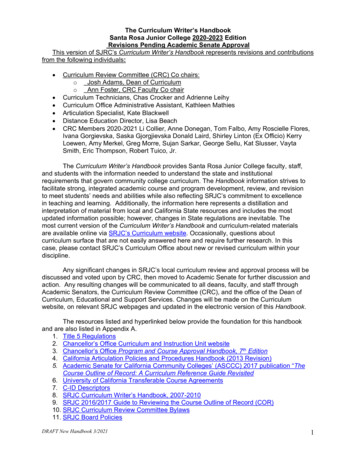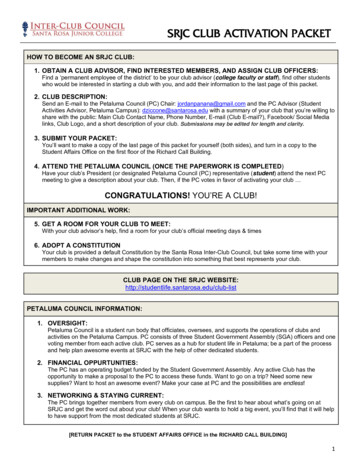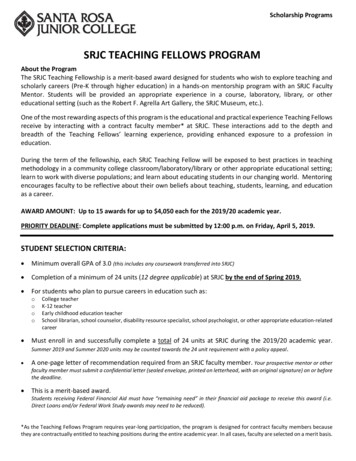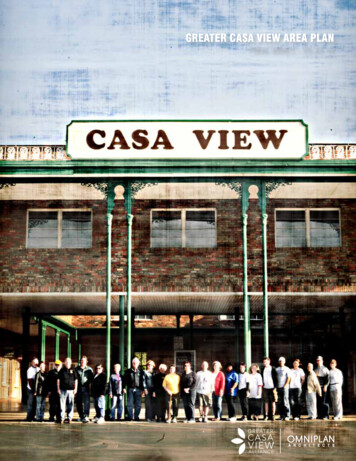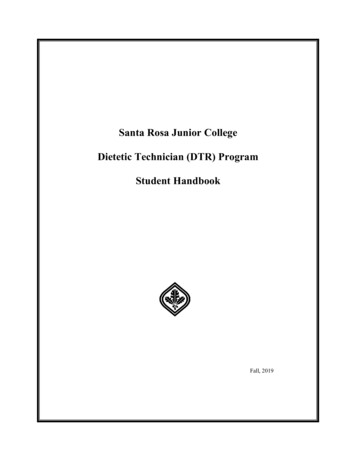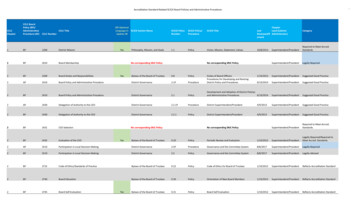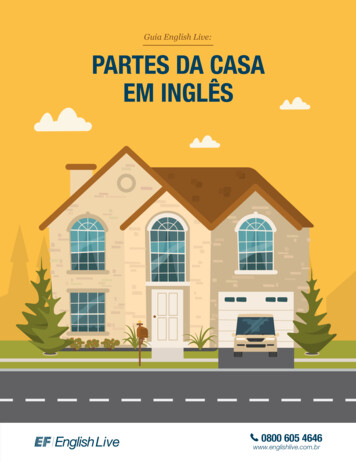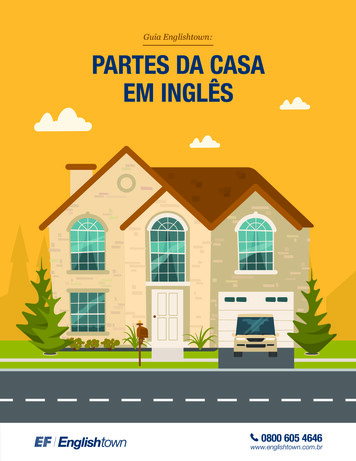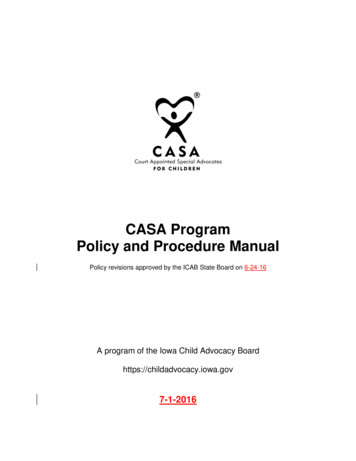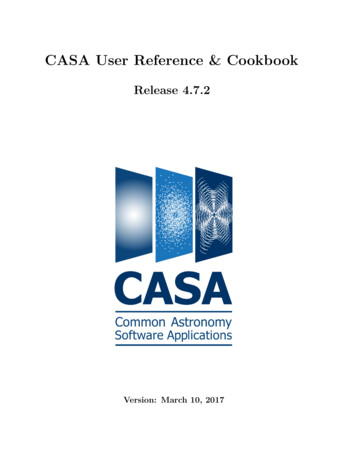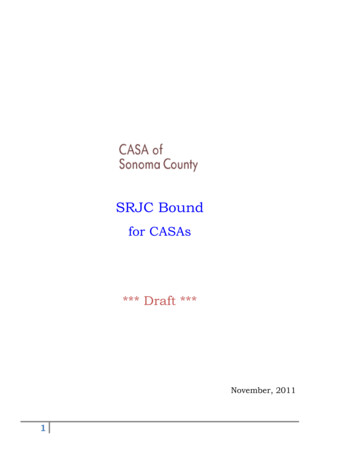
Transcription
SRJC Boundfor CASAs*** Draft ***November, 20111
SRJC Bound for CASAsTable of ContentsIntroduction . 6Preparation for SRJC . 8Conversations . 8Campus Tours . 8College Preparation . 8Middle School . 89th Grade. 910th Grade . 911th Grade . 912th Grade .10SRJC Independent Living Program (ILP) .10SRJC College Skills classes .12Academic & Basic Skills .12Academic Skills .12Basic Skills .12General College Preparatory Skills .13Reading and Writing Skills.13Computational Skills .13Tutorial Center .13High School Degree Alternatives.15GED (General Education Development) .15Requirements .15GED Labs .15CHSPE (CA High School Proficiency Examination) .16Boys & Girls Club CollegeBound Program .16SRJC Facility & Benefits .18Application & Admission .20Testing Services .212
Placement Tests .21GED (General Education Development) Test .22Fees .22Reservations.23Testing .23Identification .24Retesting .24Ability to Benefit (ABT) Test .25Orientation .26Counseling .27Registration .28Financial Assistance .29Financial Aid & Grants .31Federal Aid .31Requirements .31Federal Student Aid (FAFSA).32FAFSA Forecaster .32Federal Pell Grant .33Federal Supplemental Educational Opportunity Grant (FSEOG) .33Academic Competitiveness Grant (ACG) .33Federal Work Study (FWS) .34State (CA) Aid .34Board of Governors (BOG) Fee Waiver .34Cal Grants .35Cal Grant B .36Cal Grant C .37Extended Opportunity Programs & Services (EOPS) .38Grants for Foster Youth .39CA Chafee Grant .39CA StudentAid WebGrants 4 Students .40Financial Aid Tips .40Scholarships .41About Scholarships .41SRJC Scholarships .42SRJC Foundation & Endowed Scholarship Funds .423
SRJC Business & Community Outside Scholarship Funds .43SRJC Doyle Scholarship Funds .43Scholarships for Foster Youth .44Foster Care to Success .44Casey Family Scholars Program/Scholarship .44Sponsored Scholarship Program .45Valley of the Moon Children’s Foundation Scholarship Program .45The Burton Scholars Backpack to Success Program .45Other Financial Assistance .46CalWORKs for TANF recipients .47College Scholarships.org .48National Merit Scholarship Corporation .48National Merit Scholarship Program .49National Achievement Scholarship Program .49Gates Millennium Scholars (GMS) .49Hispanic Scholarship Fund (HSF) .50La Tortilla Factory Scholarship .50Useful Financial Aid Websites .50California State Aid .51Scholarship Directories .51College Planning and Exploration .51Other .51SRJC Programs of Study .55Associate Degree (AA/AS) Programs .55Associate Degree Requirements: .55Certificate Programs .56Certificates of Achievement .56Skills Certificates .57Resources.58CA College Pathways .58CA College Pathways .58V.O.I.C.E.S. .59Social Advocates for Youth (SAY) .60Opportunities Now .61Youth Employment Center .614
Casey Family Programs .61Community Action Partnership Vocational YouthBuild .61Foster Care to Success .62Office of Foster Care Ombudsman.63College Survival and Study Skills .63FosterClub .63Transition Toolkit .63AB 540 Students and the California Dream Act or 2011 .635
SRJC BoundIntroductionThis document was developed to assist CASAs and their current and emancipated―transitioning‖ foster youth with the various processes involved with preparing for,applying to, obtaining financial assistance for and attending classes at Santa RosaJunior College (SRJC).It was written for the primary use of the CASA and was based on actual experience withthe process as a CASA/youth team. A related document for foster youth, SRJC Boundfor Students, supplements this document. It has been customized and organizedspecifically for Sonoma County foster youth and Santa Rosa Junior College.As CASAs we want all our foster youth to reach the highest level of education ortraining they are desirous and capable of while adequately meeting their needs for food,clothing and shelter.CA Assembly Bill 490 dictates that ―Foster youth must have access to the sameacademic resources, services, extracurricular and enrichment activities available to allstudents.‖ It is intended so that foster youth have a better chance to succeed in school.The Casey Family Programs Improving Outcomes for Older Youth in Foster Care studynotes that ―Study after study shows that, as a group, foster youth fare poorly as theyattempt to negotiate the world of adulthood. Youth who age out are less likely than6
their peers in the general population to achieve academic milestones, including highschool graduation and postsecondary education that signal the foundations of selfsufficiency.‖ The study further notes that ―older youth in foster care need earlypreparation to develop aspirations, learn and practice life skills, have ―normal‖formative experiences, and otherwise become ready for adult life.‖According to the CA Department of Social Services’ Resource Directory A Guide forCurrent and Emancipated Foster Youth, ―Even if your grades were bad, you did notgraduate from high school or you received your GED, you still can go to a communitycollege and transfer to a university. Community Colleges provide financial aid and othersupport that makes it possible for foster youth and emancipated youth to attendcollege, almost free of charge. You can earn your Associate Degree or a certificate in lessthan two years of full time classes. Community college vocational training programsinclude nursing, computer programming, mechanics and electronics.‖Most of the information contained in this document was culled from:--SRJC The Catalog 2010/2011 ( 5 at SRJC Bookstore)SRJC Fall 2010 and Spring 2011 Schedule of ClassesSRJC website (www.santarosa.edu)SRJC brochuresState of California website (www.CA.gov)Numerous other websites (especially for Financial Aid & Scholarships)Resource Directory – A Guide for Current and Emancipated Foster Youthprovided by the CA Department of Social Services and the Office of theFoster Care OmbudsmanCASA Guide to Independent Living for Transitional-Age and EmancipatedFoster Youth, Alameda County CASA ProgramCasey Family Programs literatureTANF / CalWORKs / SonomaWORKs literatureHopes & Hurdles – California Foster Youth and College Financial AidInstitute for College Access&Succes October 2009California Student Aid CommissionThis document is a work-in-process. Suggestions for additions, deletions and changesare welcome. This is especially true for financial assistance opportunities. Pleaseforward suggestions to Karen Bushnell at kbushnell@msn.com.7
Preparation for SRJCIt is the theory of the CASA program that the emancipation process begins as early as14-15 years of age when the minor is encouraged to look at their skills, interests andwhat they might want to be when they ―grow up.‖ This learning experience will beginmore assertively at 15½ to prepare the youth for 16 when the Independent LivingProgram (ILP) staff will contact them to enroll in the ILP classes offered at SRJC.Other SRJC opportunities available to students without a high school degree includeCollege Skills classes and the GED Lab. Details of these classes and additionalinformation can be found below and in the Schedule of Classes catalog.ConversationsAlthough this document addresses foster youth attending SRJC, foster youth shouldunderstand that college is not the only option for a post-secondary education and formany foster youth a vocational path or trade school may make more sense. Ongoingdiscussions between CASAs and youths are a good way to begin the process ofdetermining what they want to be when they ―grow up.‖Campus ToursCampus tours are a good way to introduce foster youth to college life and are a fun, freeactivity.Free campus tours are operated throughout the year, Monday-Friday, during Fall andSpring sessions and Monday-Thursday during the summer session.Reservations are required and should be made at least one week in advance. To make areservation, contact the Tour Coordinator at (707) 527-4424.College PreparationFrom About.com College Preparation by Alan Grove:Middle SchoolWhy Middle School Actually Does Matter For College AdmissionsIn general, you don’t need to worry too much about college when you are in middleschool. Nevertheless, although your middle school grades and activities won’t appear on8
your college application, you can use 7th and 8th grades to set yourself up to have thestrongest record possible in high school.If you find that your skills in an area such as math or science aren’t what they shouldbe, middle school is a wise time to seek out extra help and tutoring. If you can improveyour academic strengths in middle school, you’ll be positioned to earn better gradeswhen it really begins to matter – in 9th grade.Always keep in mind that your middle school record doesn’t appear on your collegeapplication. You shouldn’t stress about college in 7th or 8th grade. Use these years toexplore new things and discover what subjects and activities really excite you.9th Grade9th Grade Matters for College Admissions. Here's How to Make the Most of It.College seems a long way of fin 9th grade, but you need to start thinking about itseriously now. Your 9th grade academic and extracurricular record will be part of yourcollege application.The primary advice for 9th grade can be boiled down to this: take demanding courses,keep your grades up, and be active outside the classroom.Don’t blow off your summer. Summer is a great opportunity to have meaningfulexperiences that will be rewarding for you and impressive on your college application.Travel, community service, volunteerism, sport or music camp, and employment are allgood options.10th GradeUse Sophomore Year to Create a Winning College Admissions StrategyYour college applications are still a couple years off when you start 10th grade, but youneed to keep your long-term goals in mind. Work on keeping your grades up, takingchallenging courses, and gaining depth in your extracurricular activities.There’s no formula for what defines a productive summer, but you should make sureyou do something that leads to personal growth and valuable experiences. Whateveryour passions and interests, try to plan your summer to tap into them.11th GradeUse Sophomore Year to Create a Winning College Admissions StrategyIn 11th grade, the college preparation process accelerates and you need to start payingcareful attention to looming deadlines and application requirements. You should have aplan mapped out for achieving your broad educational goals.9
11th grade is probably your most important year for earning high grades. If you hadmarginal grades in 9th or 10th grade, improvement in 11th grade shows a college thatyou’ve learned how to be a good student. A drop in your grades in 11 th grade shows amove in the wrong direction, and it will raise red flags for the college admissions folks.12th GradeKeep Track of Important Dates and Deadlines in 12th GradeSenior year is a busy and extremely important time in the college admissions process.This is your last chance to get the ACT and SAT scores you need. You’ll need to get yourcollege essay up to snuff, line up your letters or recommendation, and apply forfinancial aid. During the application process, you’ll need to keep active inextracurricular activities and maintain high grades.See SRJC Bound College Preparation Checklist for details.SRJC Independent Living Program (ILP)The Independent Living Program (ILP) has been part of SRJC since 1989. In partnershipwith Sonoma County Department of Human Services, ILP provides support andresources for youth ages 15-21 who are in foster placement or who are moving towardindependent living. Classes, workshops, and events cover topics such as collegeenrollment, housing, budgeting, banking, conflict resolution, safe choices, and goalsetting, help developing skills and resources needed to become self sufficient.Independent Living Program is state and federally funded, and all classes are free.The Independent Living Skills classes meet once a week for 1½ hours for 25.5 hours ofeducation per semester, and provide information and resources to help students helpthemselves. Topics include:-Introduction to SRJC/RegistrationEducational/Vocational Goal SettingIncome Tax PreparationFinancial AidTransportationBudgetingJobs! What is available and what you can earn.Jobs! Part 2 Resume/Role PlayingJobs! Part 3 InterviewingCareer OptionsDiet and NutritionHousing/Options & ResourcesJob LinkSRJC ResourcesAmong other things, the ILP program can help youth to:-10Get money through the Emancipated Youth Stipend to help withhousing, food and expenses after emancipation
-Get funds for driver’s trainingFind a steady job, with a good paycheckGet an apartment / Transition HousingLearn the skills to become self-sufficientGet money to finish schoolThe program consists of two courses. Therefore students can earn up to six units ofcollege credits if they take both classes twice.Part I for youth ages 15-17Independent Living Planning, BeginningCHLD 312 (Fall session) CHLD 313 (Spring session)Introduction to Independent Living Skills with a focus on vocational goal setting, planning andfinancial literacy. Includes introduction to community and college resources such as financial aid,EOPS, CalWORKs, tutorial and placement testing services, counseling, health services, andhousing information. Students will practice checkbook balancing, tax preparation and budgeting,and develop job search and interviewing skills.Part II for emancipating youth ages 17-21Independent Living Planning, AdvancedCHLD 314 (Fall session) CHLD 315 (Spring session)Advanced Independent Living Skills focuses on vocational goal setting and financial literacy inmore depth. Includes researching community and college resources such as financial aid, EOPS(Economic Opportunity Program Service), CalWORKs, tutorial and placement testing services,counseling, health and housing information services. Students will visit these resources in smallgroups and report back to the class. Students will practice checkbook balancing, prepare federaland state income tax forms, identify safe financial practices to avoid bad credit or identity theft,and practice job searches and interviewing skills.Participating students will:-Receive 3.3 high school credits per semesterReceive 1.5 college credits per semesterEarn incentive pay for each class attendedEarn additional money for participation on other ILP events throughoutthe yearIf both classes are taken twice (which is the allowable maximum), a student can earn 6college credits and, if taken while in high school, 13.2 high school credits.Additionally, ILP can help with housing, finances, plans for college, job hunting andmore.Special Events may include:-11―Independent City‖ (a mock life in a mock city)―Ropes course‖―The Awards Banquet‖Computer Whiz Day―Who Am I?‖ (Vocational assessment day)
SRJC College Skills classesThe College Skills/Tutorial Department offers classes and labs to improve basicacademic and computational skills to prepare students for college-level work and toencourage success through course-related tutoring.The College Skills Department offers students a variety of ways to improve theiracademic skills in a highly supportive and respectful environment. They can helpimprove study skills, as well as skills in math, reading, and writing, to succeed incollege or on the job.College Skills offers open-entry, open-exit Basic Skills Labs to help students brush upand improve reading, writing and/or math skills, as well as prepare for the GED test.Instruction is provided in a self-paced, supportive and stress-free learning environment.Academic & Basic SkillsThese courses allow the student to enroll throughout the semester and work at anindividual pace.There are three Academic Skills courses that are available, to be taken in sequentialorder, and one Basic Skills course:Academic Skills-Academic Skills I [CSKLS 731]math computation, reading comprehension, sentence skills, and basiccomputer skills-Academic Skills II [CSKLS 732]pre-collegiate math, reading skills, paragraph writing, and basic wordprocessing-Academic Skills III [CSKLS 733]pre-algebra, academic reading, essay-writing skills, academic computeruse, and test-taking preparationBasic Skills-12Basic Skills [CSKLS 772]math, reading, writing, basic technology skills, and test-takingpreparation
General College Preparatory SkillsPrimarily study skills:-Skills AssessmentTest-Taking StrategiesTest-Taking Preparation (reading, writing, math)How to Take an Online ClassVocation English for Speakers of Other LanguagesReading and Writing SkillsReading and Writing plus:-Spelling & Vocabulary DevelopmentGrammar and Writing ReviewEssay Writing WorkshopComputational SkillsMath and Science.Tutorial CenterThe Tutorial Center provides tutors and materials free of charge for SRJC studentsneeding assistance in their regular coursework. The people who work in the TutorialCenter are Senior Instructional Assistants who are experts in the subjects they tutorand who also enjoy helping others to succeed. Group, individual, and drop-in tutoringare provided.The tutorial program offers tutoring in ASL, Astronomy, Biology, Business, Chemistry,Economics, English, ESL, Foreign Languages, Geography, History, Math, Philosophy,Physics and other requested subjects. Drop-in tutoring is available for Math, Chemistryand for Writing assignments.13
Santa Rosa CampusDoyle Library, Room 425114Petaluma CampusDoyle Hall
High School Degree AlternativesToo many foster youth ―transition‖ without a high school degree. There are twoalternative proficiency programs: the GED and the CHSPE.GED (General Education Development)The American Council on Education recognizes successful completion of the GeneralEducational Development (GED) tests as equivalent to a high school diplomathroughout the United States.SRJC offers an extensive GED-preparation program in both English and Spanish.GED tests provide adults (age 18 and older) who did not complete a formal high schoolprogram the opportunity to certify their attainment of high school-level academicknowledge and skills.98% of colleges and universities that require a high school diploma accept the GEDcredential. 96% of companies accept applicants with a GED credential for jobs requiringa high school degree.Requirements-18 years of age or older, or within 60 days of their 18 th birthdaywithin 60 days of their graduation date had they remained in school andfollowed the usual course of study17 years of age and have been out of school for at least 60 consecutiveschool daysa minimum of a ninth grade reading levelability to add, subtract, multiply and divide by handGED LabsThese labs offer free learning opportunities to brush-up on academic skills or to preparefor the GED test and other exams such as the Math Competency Exam, CAHSEE,CHSPE, and CBEST.Each Academic Skills Lab site has instructors, computers, and materials to help withGED and placement test preparation and credit class assignments. There are no entryrequirements, but students under 18 years of age who are currently attending highschool must complete a concurrent enrollment form when they register.GED preparation classes are provided by the College Skills Department and consist of:-15Basic Academic Skills class (CSKLS 731)GED Preparation classes
-GED computer labsGED practice tests are available, as well as self-paced lab with individual instructionand concentration in language and math skills.Day, evening, and Saturday classes are available throughout the year at:Santa Rosa CampusAnaly Village Bldg H, Room 601Petaluma CampusKathleen Doyle Hall, Room 252See Assessment & Placement / GED Testing below for testing details.CHSPE (CA High School Proficiency Examination)This program was established by California law. The CHSPE consists of two sections:English-Language Arts and Mathematics. If youth pass both sections, the CA StateBoard of Education will award a Certificat
- SRJC The Catalog 2010/2011 ( 5 at SRJC Bookstore) - SRJC Fall 2010 and Spring 2011 Schedule of Classes - SRJC website (www.santarosa.edu) - SRJC brochures - State of California website (www.CA.gov) - Numerous other websites (especially for Financial Aid & Scholarships) -Resource Directory - A Guide for Current and Emancipated Foster Youth
